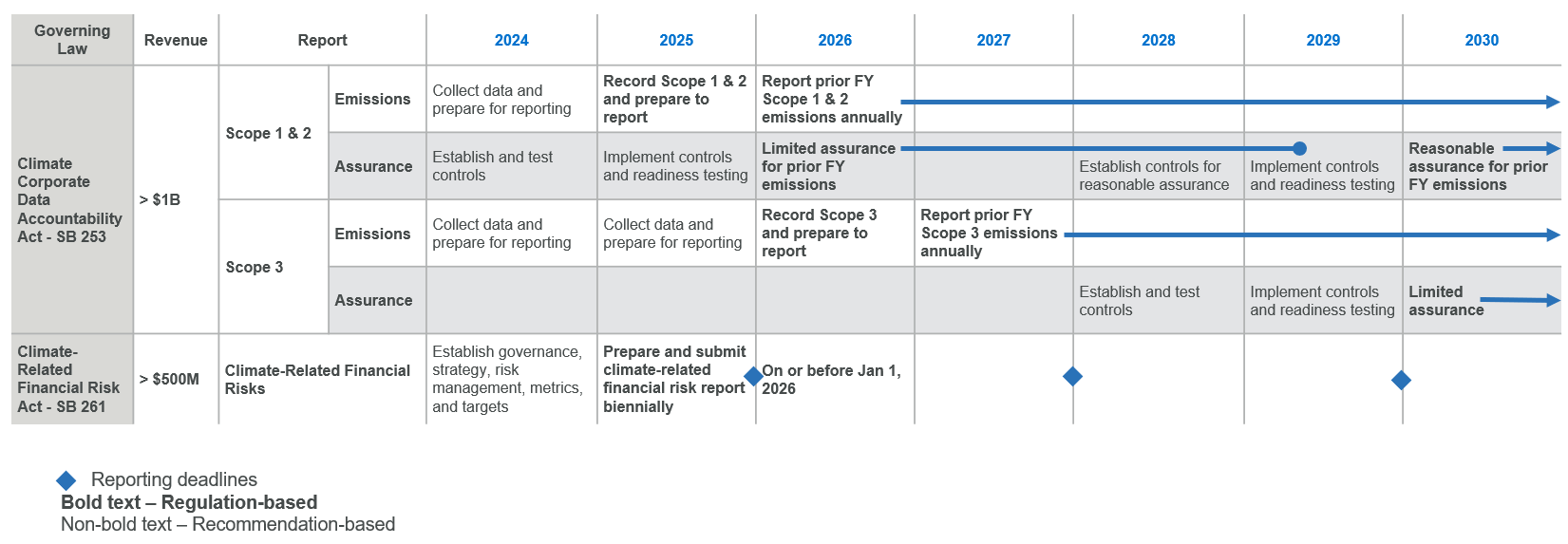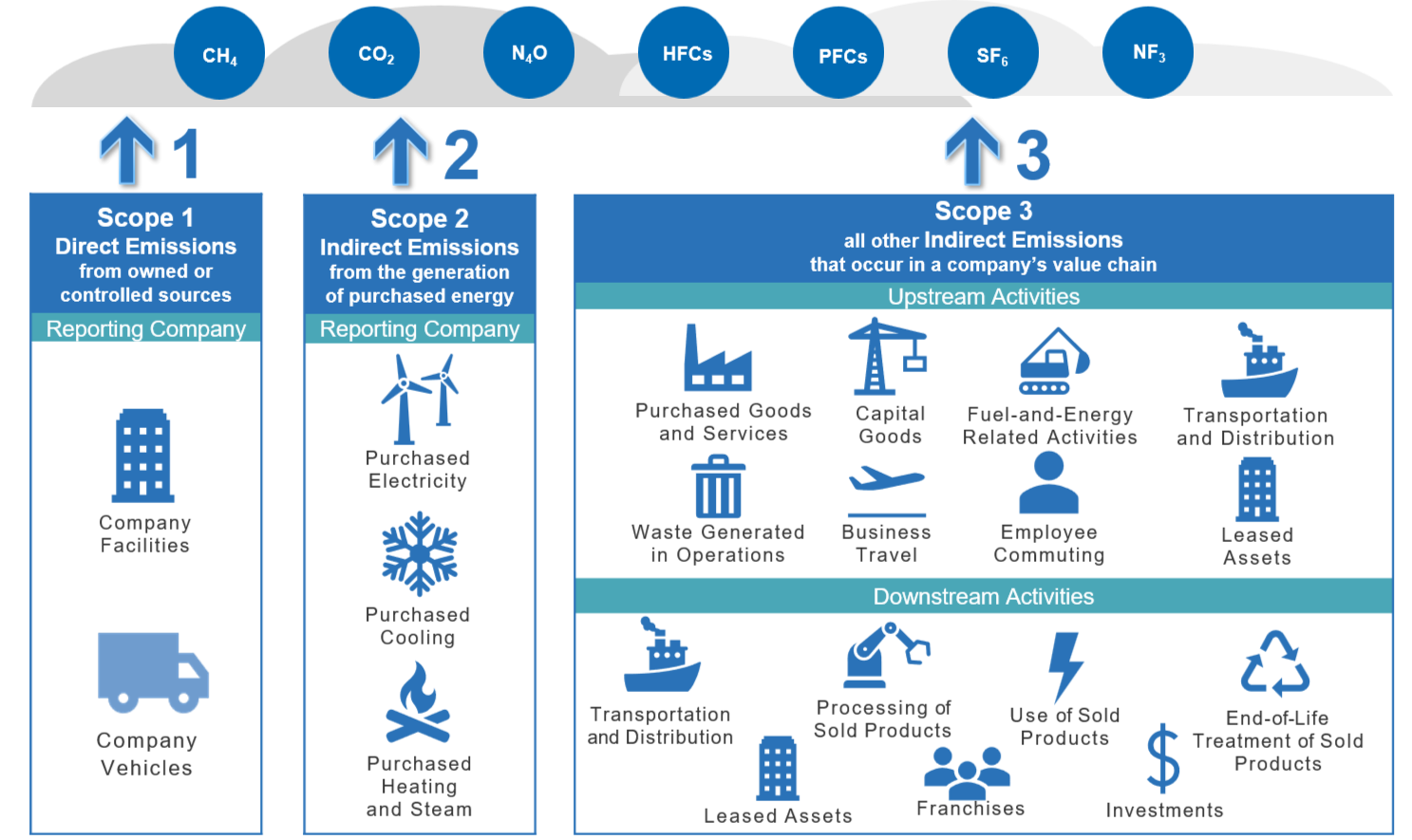In today’s fast-paced business ecosystem, the changing landscape of GHG reporting and compliance with issued guidance is synonymous with the constant threat of climate change. Organizations unfamiliar with regulatory expectations may become challenged in identifying and understanding the right path forward with GHG emissions reporting. With the recent signing of Senate Bill (SB) 219, organizations may be relieved to find detailed explanations of reporting requirements and steps needed to adequately prepare for compliance.
However, taking the steps necessary to plan for proper GHG emissions reporting will not only avoid unnecessary penalties impacting an organization’s bottom line but may also lead to future profitability with increased reporting efficiencies.
On September 27, 2024, California Governor Gavin Newsom signed Senate Bill (SB) 219 Greenhouse gases: climate corporate accountability: climate-related financial risk into law, reaffirming the requirements for U.S. companies doing business in California under the existing laws of the Climate Corporate Data Accountability Act (CCDAA, originally SB 253) and Climate-Related Financial Risk Act (originally SB 261).
SB 219 provides some flexibility in reporting, along with additional time for the promulgation of related regulations. However, the reporting deadlines for U.S. companies doing business in California remain unchanged, including the following initial deadlines:
- Fiscal year 2025: Scope 1 and 2 greenhouse gas (GHG) emissions must be reported in 2026 by companies with annual revenues greater than $1 billion.
- By January 1, 2026: Companies with annual revenues greater than $500 million require an initial report of climate-related financial risk.
The revenue thresholds are based on total revenues and are not limited to revenues earned in California.
This article summarizes the essential requirements as amended by SB 219 and includes recommended actions to take now to meet these requirements. The following graphic includes a timeline for these requirements.
Climate Corporate Data Accountability Act (CCDAA)
The CCDAA requires reporting entities to disclose GHG emissions annually, beginning with FY 2025 Scope 1 and Scope 2 emissions reported in 2026. Limited assurance is required for the first four years of reporting. Reasonable assurance is required, beginning with FY 2029 Scope 1 and 2 emissions to be reported in 2030.
Beginning with FY 2026 emissions to be reported in 2027, reporting entities must also disclose Scope 3 emissions annually. The deadline for reporting Scope 3 emissions will be determined by the California Air Resources Board (CARB). Limited assurance is required for beginning with FY 2029 Scope 3 emissions to be reported in 2030.
As shown in the graphic below, Scope 1 consists of GHG emissions from sources that a reporting entity owns or directly controls. Scope 2 consists of indirect GHG emissions from consumed electricity, steam, heating, or cooling that a reporting entity has purchased or acquired. Scope 3 comprises indirect GHG emissions from upstream and downstream activities in the reporting entity’s value chain. Examples of Scope 3 include, but are not limited to, emissions from purchased goods and services, business travel, employee commuting, and processing and use of sold products.
The SB 219 amendments provide additional flexibility in utilizing reports consolidated at the parent company level. If a subsidiary of a parent company qualifies as a reporting entity, i.e., a U.S. company doing business in California with revenues greater than $1 billion, the subsidiary is not required to prepare a separate report.
SB 219 extended CARB’s deadline to adopt implementing regulations for the CCDAA by six months to July 1, 2025.
Climate-Related Financial Risk Act
The Climate-Related Financial Risk Act requires covered entities to publish climate-related financial risk reports biennially in accordance with the following standards:
- Final Report: Recommendations of the Task Force on Climate-Related Financial Disclosures (TCFD)
- Measures adopted to reduce and adapt to climate-related financial risk
Alternatively, the company may issue a report that meets the International Financial Reporting Standards (IFRS) Sustainability Disclosure Standards (SDS), as issued by the International Sustainability Standards Board (ISSB). The first reporting deadline is January 1, 2026.
Climate-related financial risk reports may be consolidated at the parent company level. If a subsidiary of a parent company qualifies as a covered entity, i.e., a U.S. company doing business in California with revenues greater than $500 million, the subsidiary is not required to prepare a separate climate-related financial risk report.
As shown in the table below, the TCFD disclosure recommendations—now requirements in California—include 11 disclosures organized under four pillars:
| Governance | Strategy | Risk Management | Metrics & Targets |
|---|---|---|---|
| Disclose the organization’s governance around climate-related risks and opportunities. | Disclose the actual and potential impacts of climate-related risks and opportunities on business, strategy, and financial planning. | Disclose how the organization identifies, assesses, and manages climate-related risks. | Disclose the metrics and targets used to assess and manage relevant climate-related risks and opportunities. |
| a. Describe the board’s oversight of climate-related risks and opportunities. | a. Describe the climate-related risks and opportunities identified over the short, medium, and long term. | a. Describe your processes for identifying and assessing climate-related risks. | a. Disclose the metrics used to assess climate-related risks and opportunities. |
| b. Describe management’s role in assessing and managing climate-related risks and opportunities. | b. Describe the impact of climate-related risks and opportunities on businesses, strategy, and financial planning. | b. Describe the organization’s processes for managing climate-related risks. | b. Disclose Scope 1, 2, and 3 GHG emissions and related risks. |
| c. Describe the potential impact of scenarios, including a 2°C scenario, on your businesses, strategy, and financial planning. | c. Describe how processes for identifying, assessing, and managing climate-related risks are integrated into overall risk management. | c. Describe the targets used to manage climate-related risks and opportunities and performance against targets. |
Source: TCFD
Doing Business in California
“Doing business in California” is not defined in the legislation. If CARB relies on the existing definition under California’s tax law, the California Franchise Tax Board considers you to be “doing business” if you meet any of the following:1
- Engage in any transaction for the purpose of financial gain within California
- Are organized or commercially domiciled in California
- California sales, property, or payroll exceed the following amounts for 2024
- California sales exceed either 25% of sales or $735,019
- California real and tangible personal property exceeds either 25% of total property or $73,502
- California payroll compensation exceeds either 25% of payroll or $73,502
California’s Franchise Tax Board publishes updated threshold amounts annually.
Summary of the Requirements
The following table provides a summary of the major provisions of the laws:
| Climate Corporate Data Accountability Act | Climate-Related Financial Risk Act | |
|---|---|---|
| Who is impacted? | >5,000 U.S. companies
| >10,000 U.S. companies
|
| Are there exemptions? | None | Insurance companies2 |
| What is required? | Annual reports of GHG emissions | Biennial reports of climate-related financial risks |
| When is it effective? | Scopes 1 and 2 Emissions:
| First report by January 1, 2026 |
| What are the assurance requirements? | Scopes 1 and 2 Emissions:
| N/A |
| What are the reporting standards? |
| |
| What are the noncompliance penalties? | Up to $500,000/year | Up to $50,000/year |
Recommended Actions to Take Now
Collect Data
Collecting the necessary operational data, calculating emissions estimates and data reporting emissions, establishing assurance-level controls, and obtaining assurance is typically a multiyear journey for companies. California’s deadlines do not allow for the time typically taken by companies that report under the GHG Protocol.
Evaluate Applicability
To determine if your company is doing business in California, query accounts receivable, accounts payable, and payroll for California addresses.
Assess Current Practices
Evaluate your company’s existing practices for GHG emissions data collection and reporting, as well as climate-related risk management, to help identify gaps or areas to align with the GHG Protocol, the TCFD, and assurance standards.8
Develop an Action Plan
Create a comprehensive plan outlining the necessary steps to comply with the requirements. Identify and evaluate where efficiencies may be gained by building upon existing business processes, data collection efforts, reports, and IT systems.
Implement Necessary Changes
Make required changes to your company’s processes, systems, and documentation to comply with the requirements. These adjustments may involve updating data management practices or reporting mechanisms.
Monitor Regulatory Updates
Stay updated on clarifications to requirements that develop during CARB’s rule-making process in 2025.
Conclusion
The ESG & Climate Risk team at Forvis Mazars has many years of experience with GHG emissions reporting and financial risk management. We can help you prepare GHG emissions and climate-related financial risk disclosures to meet California’s requirements. We can assist with assurance readiness and the development of internal controls for GHG emissions reporting. We also can help you develop mitigation and adaptation strategies to manage your climate-related financial risks. If you have any questions or need assistance, please reach out to a professional at Forvis Mazars.
- The 1-2-3s of the GHG Protocol: Tips for California Climate Reporting
- Climate Change Has Broad Economic Implications Now & in the Future – How Will It Affect Your Business?
- Attestation and Internal Control Considerations for ESG Programs
- Behind the Curtain: What You Need to Know About ESG Assurance
- 1See the California Franchise Tax Board’s definition of “doing business in California” as established under Cal. Rev. and Tax Code § 23101.
- 2As of April 8, 2022, insurance companies already are required to make an equivalent report.
- 3The California Air Resources Board is to adopt regulations for the Climate Corporate Data Accountability Act by July 1, 2025.
- 4“Corporate Standard,” ghgprotocol.org.
- 5“Corporate Value Chain (Scope 3) Standard,” ghgprotocol.org.
- 6“Recommendations of the Task Force on Climate-Related Financial Disclosures,” fsb.org, June 2017.
- 7See “IFRS S1 General Requirements for Disclosure of Sustainability-related Financial Information” and “IFRS S2 Climate-related Disclosures.”
- 8“Attestation Engagements on Sustainability Information (Including Greenhouse Gas Emissions Information and Climate-Related Financial Disclosures,” aicpa-cima.com, 2023.


